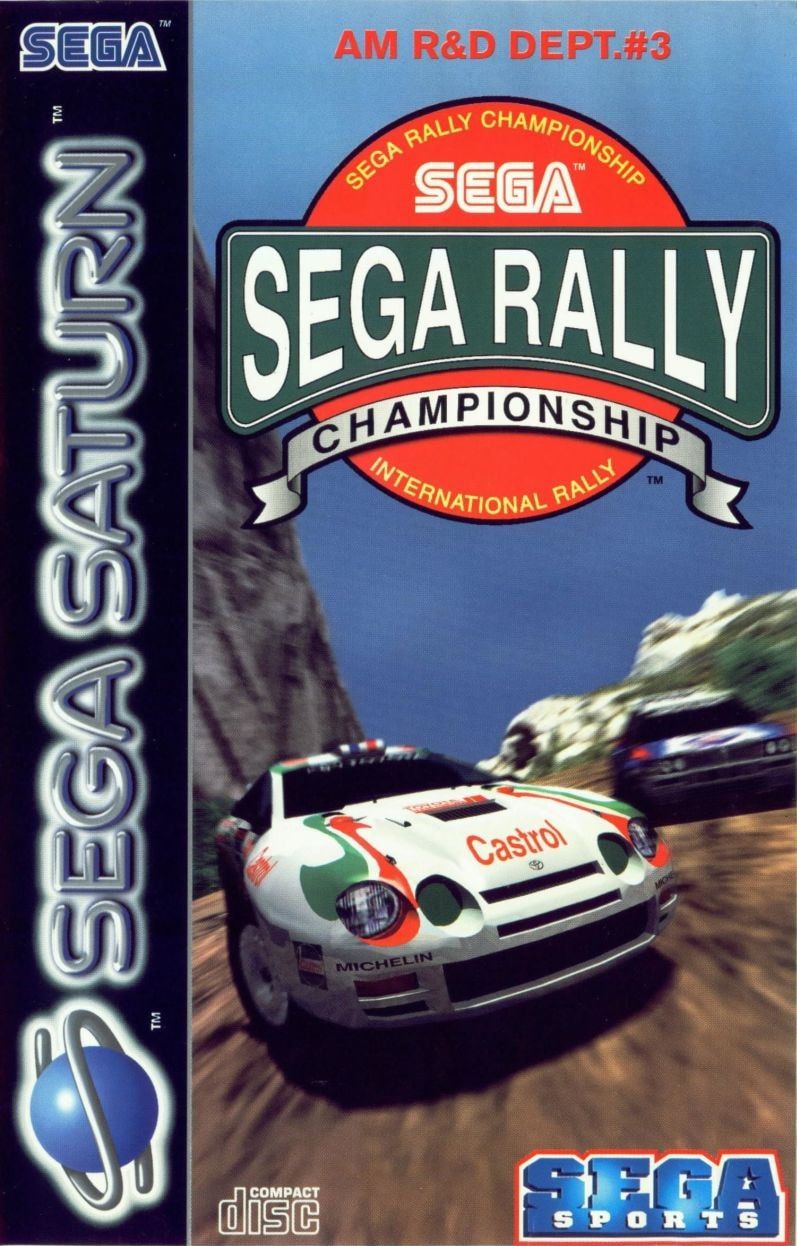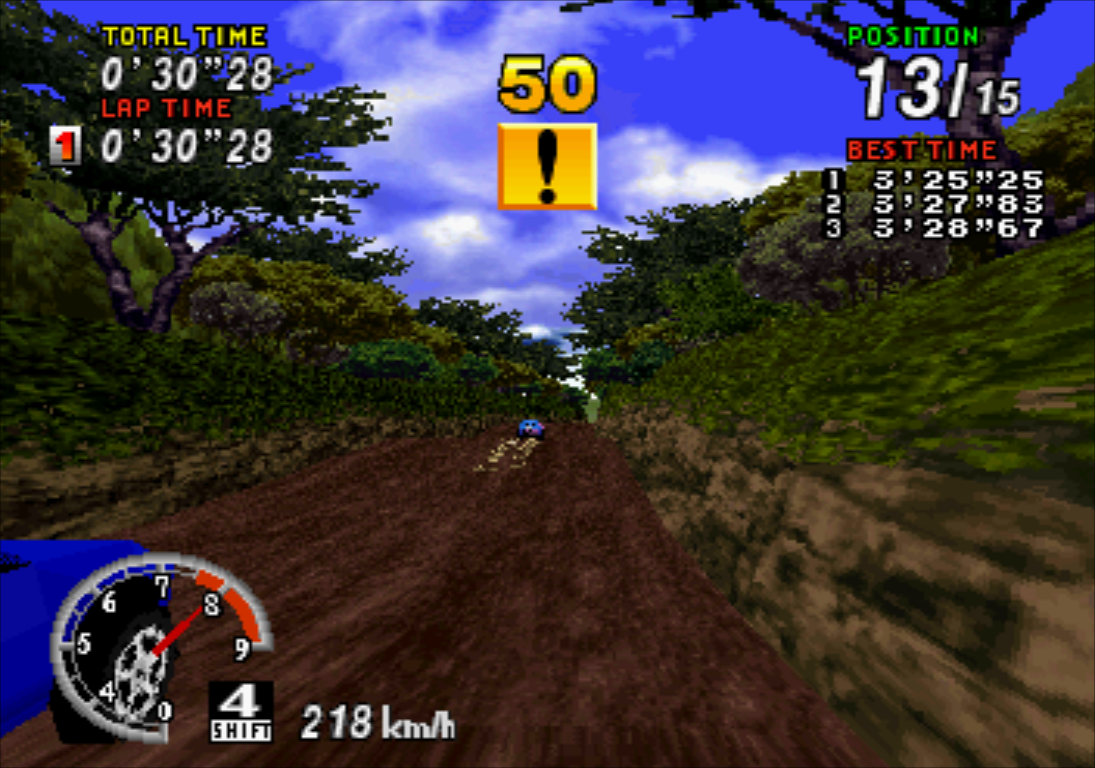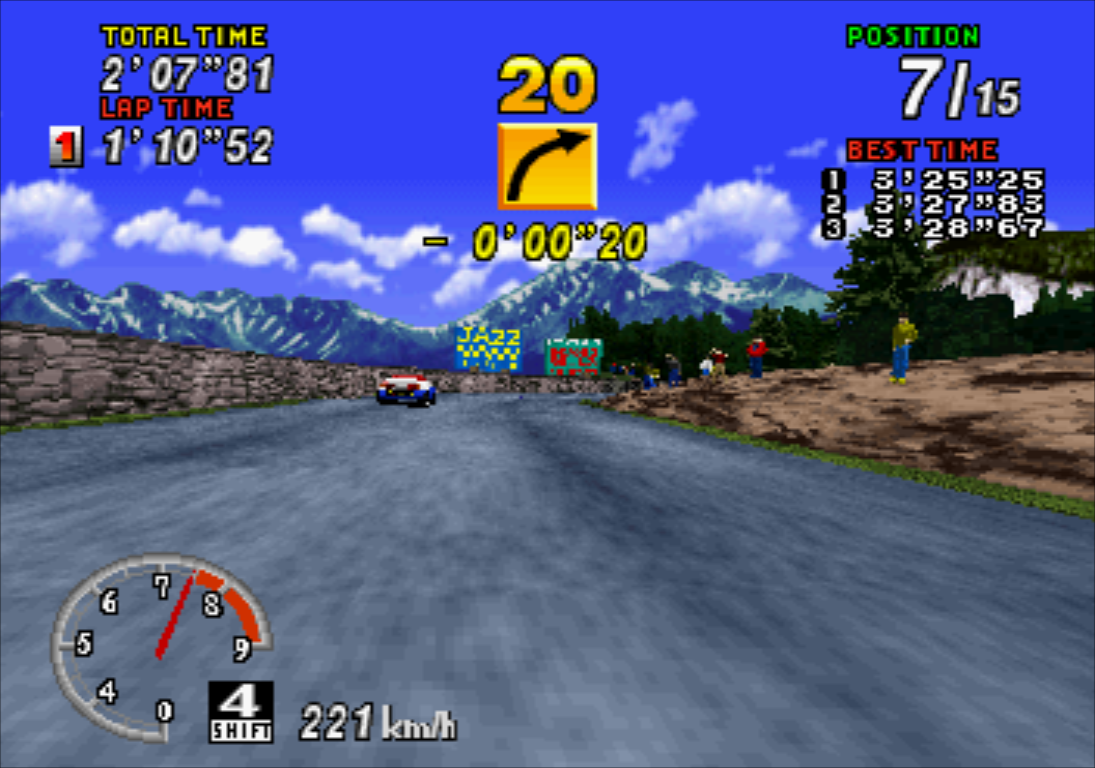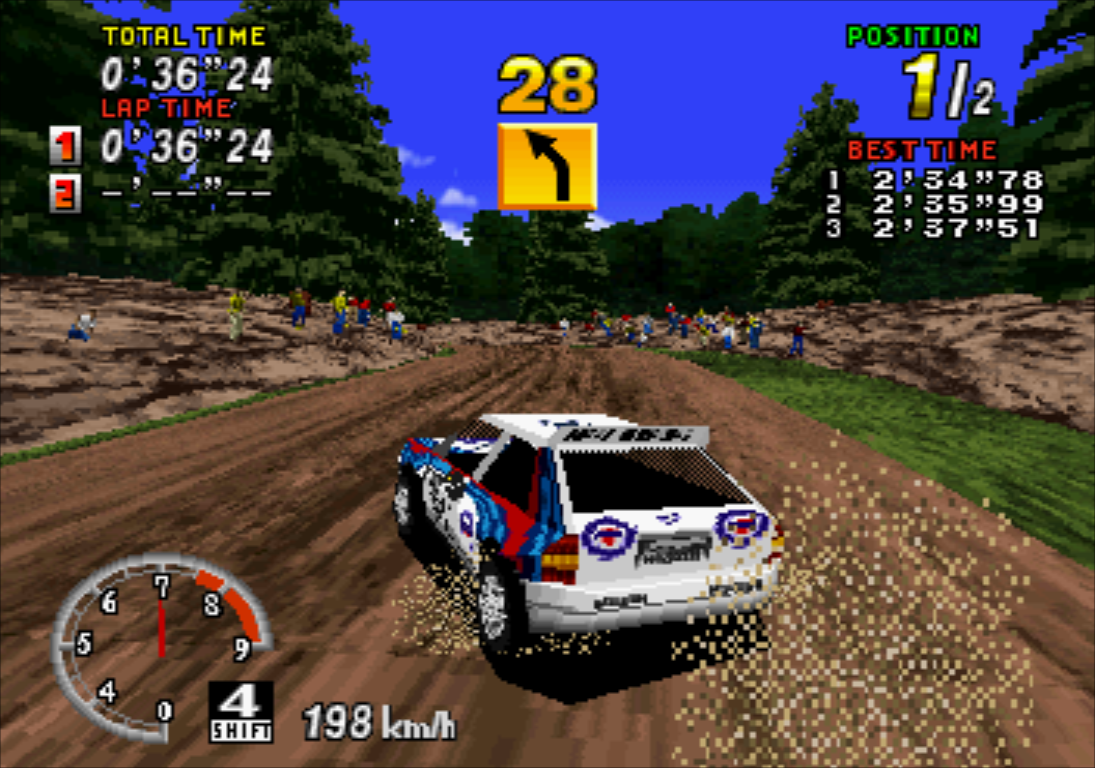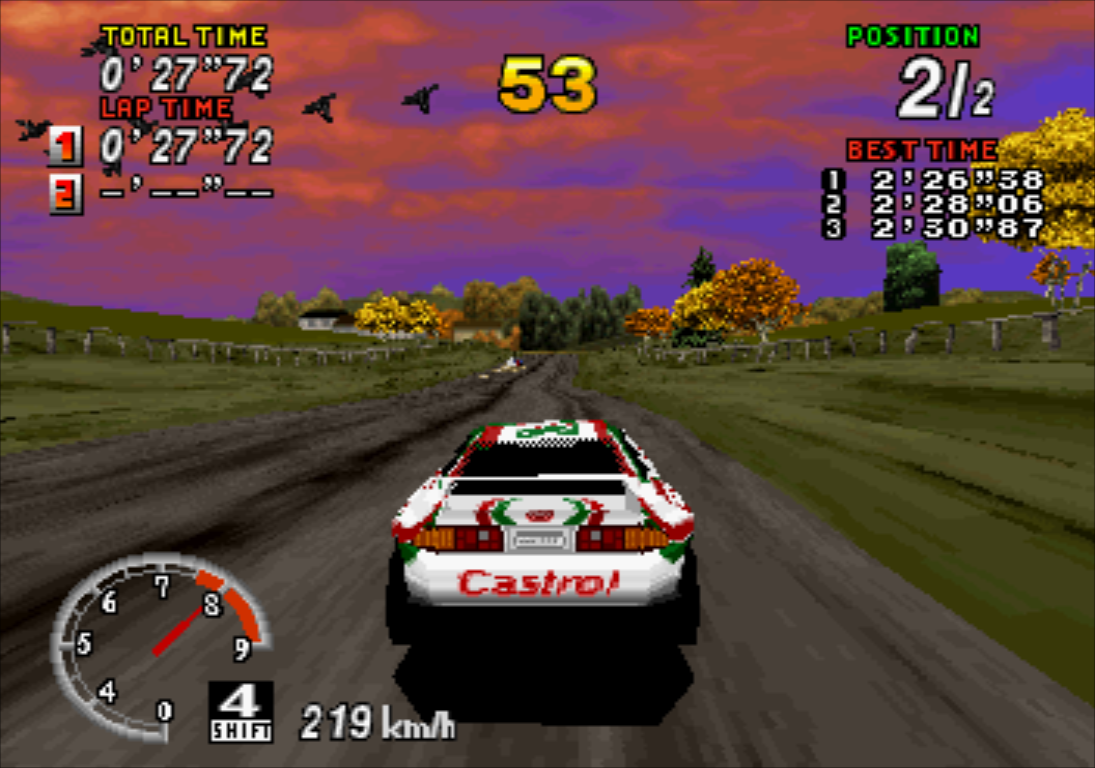SEGA RALLY CHAMPIONSHIP (SAT)
Daytona USA hadn’t quite managed to set the Saturn alight as might have been hoped for and with Ridge Racer setting a fearsome early benchmark on the rival PlayStation platform, the onus was on SEGA to energise the Saturn’s charge at the beginning of 1996. Director Kenji Sasaki was the answer to their prayers, having jumped ship from Namco to SEGA a couple of years prior. His task was to do for rally racing what he, through Ridge Racer, had already done for road racing. We lament that SEGA Rally Championship was never fully capitalised on, used to inspire bigger and better racers during the Saturn’s run, but during a time when consoles were desperate to showcase their early-3D arcade racer ports, this was arguably the best of the lot.
Sticking closely to the iconic 1994 arcade game, SRC proved an excellent port, capturing the speed, style and, most importantly, the control of the coin-op cabinet. Driving either the Toyota Celica or the Lancia Delta, the player must complete three exciting stages: Desert, Forest and Mountain. Unimaginatively named as they may have been, these offered gamers the first instance of 3D, multi-surface rally racing, with varying degrees of friction, understeer and oversteer, depending on what’s under the tyres. The game can single-handedly claim to have both revitalised and revolutionised the genre. By the mid-nineties, rally games were out of vogue, perhaps as a consequence of developers sticking doggedly to top-down or isometric overhead viewpoints, including SNK’s Drift Out series, of which both its instalments had released after SRC released in arcades. SEGA Rally Championship’s influence cannot be understated: it would take more than a year for an initial wave of imitators, the likes of V-Rally, Top Gear Rally and Rally Cross, to follow in its footsteps.
Two of gaming's most iconic rally cars, together in one screenshot! Give the people what they want etc.
In theory, the trio of tracks can be bested in a matter of minutes, but a sprinkling of additions help draw the player back, time and again. Three difficulty settings ensure players don’t have to be experts to beat SRC, but if you want to unlock some of its goodies, you’ll need plenty of practice. The more manageable bonus is a tricky fourth track, Lakeside, the reward for reaching the end of the arcade stages in first position. To unlock the beastly Lancia Stratos though, you’re going to have to put in hours and hours of practice. Finishing first and beating the final stage on at least Normal difficulty demands an almost perfect run.
All of this would be of little consequence had SEGA Rally Championship not played well, but fortunately, it runs like a dream. The result of its superbly intuitive handling is some absolutely spellbinding gameplay. There’s a perfect amount of weight to the slides and an appreciable difference in behaviour across the different road surfaces. Battling against physical competitors is also a cool touch, giving races a lively feel. It’s a huge amount of fun but also supremely challenging, encouraging the player to understand the cars and master the courses. Speaking of which, the tracks are absolute magic.
All of this would be of little consequence had SEGA Rally Championship not played well, but fortunately, it runs like a dream. The result of its superbly intuitive handling is some absolutely spellbinding gameplay. There’s a perfect amount of weight to the slides and an appreciable difference in behaviour across the different road surfaces. Battling against physical competitors is also a cool touch, giving races a lively feel. It’s a huge amount of fun but also supremely challenging, encouraging the player to understand the cars and master the courses. Speaking of which, the tracks are absolute magic.
The Desert course kicks things off and though it may seem simple, its mix of fast sweeps, stomach-churning jumps and a full-speed, hold-your-breath chicane makes for a tremendously enjoyable opener. Forest thrills with its high-speed tarmac ascent, before assailing the player in quick time with a tunnel, a sequence of sharp corners and some tight switchbacks, where the real skill is keeping peddle to the metal for as long as you dare. Mountain ups the ante still further, opening with a tight, coastal tarmac section as you tackle a sequence of tight bends on narrow roads, somewhat reminiscent of the Cote d’Azur. Escape this section and there’s no time to relax, as the player is abruptly met with a gravel section to keep you on your toes. The bonus Lakeside course is the toughest of the lot, a muddy route that sees slow-to-instigate slides which, when coupled with numerous, persistently tight corners, makes for a real headache. You’ll need to have mastered the game’s physics to get a quick lap out of this one.
But for a little bit of pop-in here and there, SEGA Rally Championship is almost flawless, visually. Its gorgeous tracks bear the hallmarks of Sasaki’s involvement in Ridge Racer, each circuit is a spectacle unto itself. Roadsides dance with cheering fans, advertisement hoardings and birds scattering as the player rockets past. Fantastically detailed buildings and structures present no compromising effect on the game’s rapid, smooth gameplay. Though there’s only two cars, SRC’s are far superior to its contemporaries, not only beautifully crafted and far less boxy-looking than other mid-nineties racers, their motion is convincing (and playable) from the external viewpoint, too. The only design quirk that spoils things is the overbearing, garish purple sky that dominates the Lakeside course. Otherwise, it looks sublime.
But for a little bit of pop-in here and there, SEGA Rally Championship is almost flawless, visually. Its gorgeous tracks bear the hallmarks of Sasaki’s involvement in Ridge Racer, each circuit is a spectacle unto itself. Roadsides dance with cheering fans, advertisement hoardings and birds scattering as the player rockets past. Fantastically detailed buildings and structures present no compromising effect on the game’s rapid, smooth gameplay. Though there’s only two cars, SRC’s are far superior to its contemporaries, not only beautifully crafted and far less boxy-looking than other mid-nineties racers, their motion is convincing (and playable) from the external viewpoint, too. The only design quirk that spoils things is the overbearing, garish purple sky that dominates the Lakeside course. Otherwise, it looks sublime.
This being SEGA, the music makes for a rather odd (being diplomatic) fit. Whilst players might enjoy the tunes shorn of context, it’s difficult to make a case for them being a good match for a break-neck arcade racing game. That said, the title music is really nice, the engine notes and tyre screeches are suitably marvellous, and some of the dialogue calls (“Game Over yeeeeah!”) are iconic.
One of SEGA Rally Championship’s most impressive features is its two-player battle. Common sense design sees the removal of a few less prevalent trackside details, such as trees and bushes, allowing the game to run well whilst being rendered twice. Though some of the more adventurous visual details are therefore sacrificed, the result is nevertheless a treat.
One of SEGA Rally Championship’s most impressive features is its two-player battle. Common sense design sees the removal of a few less prevalent trackside details, such as trees and bushes, allowing the game to run well whilst being rendered twice. Though some of the more adventurous visual details are therefore sacrificed, the result is nevertheless a treat.
The unlockable Lakeside track is tremendously challenging. Beat this and you'll be a worthy champion.
Could the game have been a little longer? Undoubtedly. Four courses and three cars, after everything has been unlocked, is a little paltry. The Time Attack mode would not ordinarily be considered a primary game mode, and can only be deemed as much thanks to the brilliance of SRC’s gameplay. The aforementioned two-player mode is a big plus, however. Ridge Racer had to wait until its second instalment for link cable multiplayer. It wasn’t until 1999, with Ridge Racer Type 4, that it finally offered split-screen play.
Great gameplay always stands the test of time, and few racers have managed to balance innovation, challenge and enjoyment quite so joyously as SEGA Rally Championship. The well-worn phrase ‘arcade perfect’ was soon afterwards (thankfully) consigned to history, but the excellence of AM3’s Saturn port should never be understated. Kenji Sasaki’s remarkable contribution to the racing genre would see two absolute classics releasing on consoles within a few months of one another. Personal preference will likely have been influenced by the platform you grew up with, or whether road or rally is your preferred racing discipline. There is no wrong answer, but for my money, SEGA Rally just shades Ridge Racer thanks to the variety of its handling characteristics and the distinctiveness of its course design.
Great gameplay always stands the test of time, and few racers have managed to balance innovation, challenge and enjoyment quite so joyously as SEGA Rally Championship. The well-worn phrase ‘arcade perfect’ was soon afterwards (thankfully) consigned to history, but the excellence of AM3’s Saturn port should never be understated. Kenji Sasaki’s remarkable contribution to the racing genre would see two absolute classics releasing on consoles within a few months of one another. Personal preference will likely have been influenced by the platform you grew up with, or whether road or rally is your preferred racing discipline. There is no wrong answer, but for my money, SEGA Rally just shades Ridge Racer thanks to the variety of its handling characteristics and the distinctiveness of its course design.
|
|
VERDICT
"Kenji Sasaki’s remarkable contribution to the racing genre would see two classics releasing on consoles within a few months of one another. For my money, SEGA Rally just shades Ridge Racer thanks to the variety of its handling characteristics and the distinctiveness of its course design." OVERALL: 9/10 |
